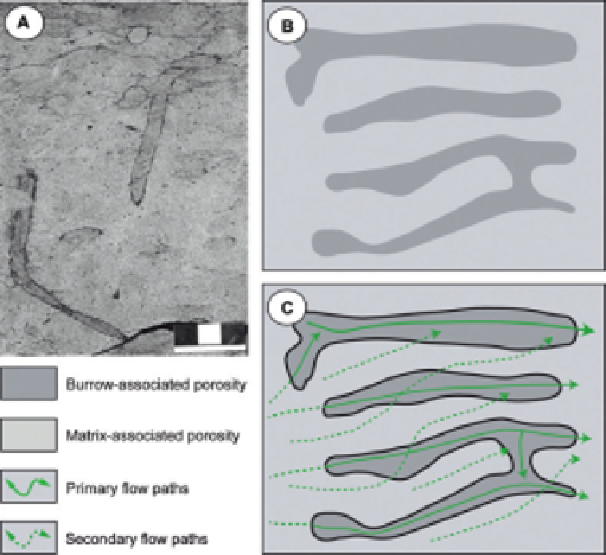Environmental Engineering Reference
In-Depth Information
bulk-permeability enhancement. The nature of permeability enhancement can
be described as either dual-porosity flow media or as dual-permeability flow
media. Dual-porosity flowmedia include burrowed sediment wherein the matrix
permeability is within two orders of magnitude of the burrow permeabilities
(
Fig. 1
). In examples where the matrix permeability and the burrow permeability
differ by three orders of magnitude or more, a dual-permeability flow network is
established (
Fig. 2
).
In dual-porosity flow media, most of the rock volume is used to conduct
flow. Although a larger fluid flux occurs through the higher permeability
zones, flow interactions between burrows and the matrix are extensive
(
Fig. 1
). This has several implications regarding reservoir behavior: (1) more
pore volume contributes to fluid or gas production; (2) due to capillarity, mul-
tiphase fluid transport may lead to segregation of the different fluid phases
(e.g., oil may be isolated in finer-grained parts of the reservoir); and (3)
advection will be dominant over diffusion (in other words, resource flows
through the stratum in response to a hydraulic gradient). Broadly speaking,
FIGURE 1
Fluid-flow behavior in dual-porosity biogenic fabrics. (A) Slabbed core image of
sand-filled burrows encased in a sandstone matrix (
Ophiomorpha
and vague
Thalassinoides
are dis-
cernible). (B) Schematic sedimentary rock with bioturbation shown as darker gray. (C) Within dual-
porosity flow media, fluid is advected through both the matrix and the trace-fossil fill. Where the
trace-fossil permeability is higher, a greater flux exists in the burrows.










Search WWH ::

Custom Search